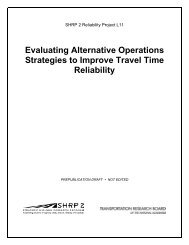Contemporary Approaches to Parking Pricing: - FHWA Operations
Contemporary Approaches to Parking Pricing: - FHWA Operations
Contemporary Approaches to Parking Pricing: - FHWA Operations
You also want an ePaper? Increase the reach of your titles
YUMPU automatically turns print PDFs into web optimized ePapers that Google loves.
Studies also found illegal parking by employees <strong>to</strong> be a common occurrence throughout busy civic areas, negatively<br />
impacting pedestrian safety, economic activity, emergency vehicle access, and public perception of government<br />
employees (Schaller Consulting, 2006).<br />
There has been some discussion of addressing employee parking issues in New York City by offering employees recurring<br />
cash payments <strong>to</strong> relinquish their parking placards. This would be the equivalent of a parking cash-out<br />
program. It would be possible <strong>to</strong> price the cash out at a value lower than the revenue currently lost from employees<br />
parking at meters that could otherwise generate revenue. Another option that has been discussed is <strong>to</strong> offer employees<br />
in-car meters loaded with a negotiated value that allow employees <strong>to</strong> park throughout the city. The meters<br />
would be an employee benefit that would replace parking placards that offer unlimited free parking.<br />
San Francisco has revised its employee-parking benefits as part of its larger parking program adjustments. In one<br />
initiative, San Francisco Municipal Transportation Agency (SFMTA) employees, many of whom were parking for<br />
free at off-street lots attached <strong>to</strong> various facilities (e.g., bus yards), lost the privilege <strong>to</strong> park for free. All SFMTA<br />
employees must now pay <strong>to</strong> park unless the right <strong>to</strong> free parking is in their labor agreement. In a second initiative,<br />
all city vehicles lost their exemption from paying meters and adhering <strong>to</strong> parking time limits. A few exceptions<br />
exist for vehicles such as police, fire, and maintenance.<br />
The City of Austin, Texas is initiating a pilot parking cash-out program in the spring of 2012 in lieu of free employee<br />
garage parking. The goal of the program is <strong>to</strong> reduce peak traffic congestion and increase the availability of<br />
visi<strong>to</strong>r parking. The volunteer program, with a one-year budget of $40,000, allows all 450 down<strong>to</strong>wn city employees<br />
<strong>to</strong> register and receive a $50 a month incentive for leaving their car at home. Employees are offered a free Capital<br />
Metro transit pass, guaranteed rides home in emergencies, and personalized commute assistance. Down<strong>to</strong>wn city<br />
employees currently are able <strong>to</strong> park for free at the Austin City Hall garage, which is leased by the city at a cost of<br />
$150,000 annually, or $100 per space per month (Coppola, 2012). The program goal is <strong>to</strong> encourage 100 employees<br />
who drove <strong>to</strong> work alone <strong>to</strong> commute <strong>to</strong> work differently, minimize down<strong>to</strong>wn traffic congestion, promote transit<br />
alternatives for city workers, and increase visi<strong>to</strong>r parking. The city will moni<strong>to</strong>r employee compliance by requiring<br />
employees who drive and park <strong>to</strong> sign-in.<br />
5.5 Car Sharing<br />
Car sharing is growing quickly in the United States. Users sign up for a membership and<br />
are able <strong>to</strong> rent cars for short time periods with gas and insurance included in the cost.<br />
Cars are s<strong>to</strong>red in numerous locations throughout cities, and various methods are used <strong>to</strong><br />
allow members <strong>to</strong> gain access <strong>to</strong> and start the vehicles. Car sharing differs from typical<br />
rental car services in that vehicles can be rented for a short period, as little as 30 minutes;<br />
vehicles are not s<strong>to</strong>red at a central location; rental fees typically include gasoline and insurance;<br />
and users are typically required <strong>to</strong> purchase a membership. Zipcar, Hertz, and<br />
Enterprise operate car sharing nationally, while numerous smaller agencies or non-profits<br />
provide service <strong>to</strong> limited geographic areas.<br />
It is estimated that one car-share vehicle can remove four <strong>to</strong> five vehicles from the road<br />
(Millard-Ball et al. 2005, 4-7). Unfortunately, finding locations where car-share vehicles<br />
can be s<strong>to</strong>red between uses can be a challenge for both cities and car-share opera<strong>to</strong>rs. Cars<br />
are typically s<strong>to</strong>red in three types of locations:<br />
(1) Within residential developments;<br />
(2) In off-street commercial facilities; and<br />
(3) On street.<br />
Pho<strong>to</strong> credit: City of Hoboken, NJ<br />
C o n t e m p o r a r y A p p r o a c h e s t o P a r k i n g P r i c i n g | 27















